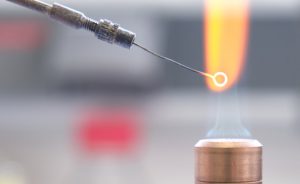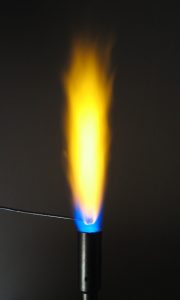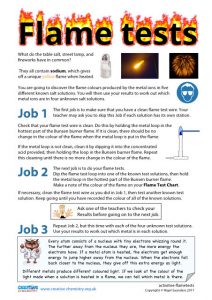
What's it all about?
You can be an analytical chemist or forensic scientist in this activity. You can discover the different coloured flames made by metal ions, and use these to work out the identity of the metal ions in some ‘unknown’ salt solutions.
Student notes
 There are three main stages in this activity:
There are three main stages in this activity:
- cleaning the wire
- observing flame colours
- identifying the metal ions in “unknown” solutions
Cleaning the wire
First make sure that you have a clean flame test wire. Do this by holding the metal loop in the hottest part of the Bunsen burner flame. If it is clean, there should be no change in the colour of the flame when the metal loop is put in it.
If it is not clean, clean it by dipping it into the concentrated acid provided, then holding the loop in the Bunsen burner flame. Repeat this cleaning until there is no more change in the colour of the flame.

Observing flame colours
The next job is to do your flame tests. Dip the flame test loop into one of the known test solutions, then hold the metal loop in the edge of the Bunsen burner flame. Make a note of the colour of the flame on your Flame Test Chart (a simple version is shown below).
| Flame test chart | |||||
|---|---|---|---|---|---|
| Name: | |||||
| Metal ion | lithium, Li+ | sodium, Na+ | potassium, K+ | calcium, Ca2+ | copper(II), Cu2+ |
| Flame colour | |||||
Clean the flame test wire, then test another known test solution. Keep going until you have recorded the colour of all of the known solutions. Get your results checked.

Søren Wedel Nielsen, CC BY-SA 3.0, via Wikimedia Commons
Identifying metal ions
| Flame test chart | ||||
|---|---|---|---|---|
| Name: | ||||
| Unknown solution | 1 | 2 | 3 | 4 |
| Flame colour | ||||
| Metal ion | ||||
Compare the flame test colours so you can work out which metal ions are present in each unknown solution.

Søren Wedel Nielsen, CC BY-SA 4.0, via Wikimedia Commons
Teacher Guide
Activity notes
 We investigate lithium, sodium, potassium, calcium and copper(II) salts. They give readily identifiable colours and are specified for GCSE courses. Solutions are safer to use than solids, although both work in flame tests.
We investigate lithium, sodium, potassium, calcium and copper(II) salts. They give readily identifiable colours and are specified for GCSE courses. Solutions are safer to use than solids, although both work in flame tests.
The activity is most easily carried out using different stations, one for each solution and with labelled flame test loops. This avoids the need to clean the flame test loops, and is desirable if adequate supervision of the students cannot be obtained. If required, the flame test wires can be cleaned between each test by dipping in hydrochloric acid and heating. Sodium ions in particular are difficult to remove, and students will end up thinking everything contains sodium or makes a yellow flame! The expected colours are shown in the table below.
| Metal ion | Flame test colour |
|---|---|
| lithium, Li+ | red (crimson) |
| sodium, Na+ | yellow |
| potassium, K+ | lilac |
| calcium, Ca2+ | orange-red |
| copper(II), Cu2+ | blue-green |
![]() Health and Safety
Health and Safety
When considering carrying out a practical activity with a class, you must check your local health and safety rules. Make an appropriate risk assessment and try the activity yourself first.
![]() 5 M hydrochloric acid
5 M hydrochloric acid
Irritating to the skin, eyes and respiratory system. Wear eye protection. Avoid skin contact and do not inhale the vapour.
![]() Salt solutions
Salt solutions
At a concentration of 0.5 M, these metal chlorides are low hazard. Note that 0.5 M copper(II) sulfate is corrosive to the eyes and irritant to the skin, so copper(II) chloride solution is preferable.
Technician notes
In the lab:
Test-tube racks
Heat-resistant mats
Bunsen burners
Nichrome flame test wires (minimum of 10, cleaned)
5 M hydrochloric acid in labelled test tubes ![]()
Flame test charts (1 per student)
In test tubes, approximately 0.5 M solutions of:
lithium chloride (labelled Li+)
sodium chloride (labelled Na+)
potassium chloride (labelled K+)
calcium chloride (labelled Ca2+)
copper(II) chloride (labelled Cu2+)
Four of these five solutions as unknowns (labelled 1, 2, 3 and 4)
Maintain stocks of these solutions for replenishment.

